Abstract
This study evaluates the Quantification de L’Activite Physique en Altitude chez les Enfants (QAPACE) supervised self-administered questionnaire reproducibility and validity on the estimation of the mean daily energy expenditure (DEE) on Bogotá’s schoolchildren. The comprehension was assessed on 324 students, whereas the reproducibility was studied on a different random sample of 162 who were exposed twice to it. Reproducibility was assessed using both the Bland-Altman plot and the intra-class correlation coefficient (ICC). The validity was studied in a sample of 18 girls and 18 boys randomly selected, which completed the test - re-test study. The DEE derived from the questionnaire was compared with the laboratory measurement results of the peak oxygen uptake (Peak VO2) from ergo-spirometry and Leger Test. The reproducibility ICC was 0.96 (95% C.I. 0.95-0.97); by age categories 8-10, 0.94 (0.89-0. 97); 11-13, 0.98 (0.96- 0.99); 14-16, 0.95 (0.91-0.98). The ICC between mean TEE as estimated by the questionnaire and the direct and indirect Peak VO2 was 0.76 (0.66) (p<0.01); by age categories, 8-10, 11-13, and 14-16 were 0.89 (0.87), 0.76 (0.78) and 0.88 (0.80) respectively. The QAPACE questionnaire is reproducible and valid for estimating PA and showed a high correlation with the Peak VO2 uptake.
Key points.
The presence of a supervisor, the limited size of the group with the possibility of answering to their questions could explain the high reproducibility for this questionnaire.
No study in the literature had directly addressed the issue of estimating a yearly average PA including school and vacation period.
A two step procedure, in the population of schoolchildren of Bogotá, gives confidence in the use of the QAPACE questionnaire in a large epidemiological survey in related populations.
Key words: Physical activity, questionnaire, validity, children, adolescents
Introduction
The increase in physical activity (PA) in young ages could prevent or delay the onset of adult pathological states (Pols et al., 1997). PA can be objectively measured by different methods some of which require special equipment and are not very well adapted to a large sample study of children. Questionnaires, interviews and diaries represent subjective methods for estimating PA, which are usually preferred in epidemiological studies.
Objective methods for measuring PA combine video, movement’s counters, accelerometer, heart rate monitoring, blood pressure monitoring, electromyography, anthropometry, fitness, VO2 metabolic cart or VO2 portable equipment, respiration chamber and doubly labelled water (DLW). However, they require special equipment and are not very well adapted to a large sample study of children.
Questionnaires, interviews and diaries represent subjective methods for estimating PA, which are usually preferred in epidemiological studies. A supervised self-administered questionnaire appeared as the most feasible and economically appropriate approach to address the specific objective of the Bogotá study. However, a PA questionnaire must fulfill the following criteria i) non-reactiveness, i.e. it does not alter the behavior of the study population; ii) practicability; iii) applicability, i.e. it is particularly designed to suit the population; and iv) accuracy, i.e. it is reliable and valid (Caspersen et al., 1998). An activity questionnaire is valid when it is able to rank individuals or groups of subjects within a population from the least to the most active, with a good correlation with relevant physiologic parameters or disease outcomes (Kriska and Caspersen, 1997). Little is known about PA in Latin American children thus an epidemiological study was launched by the El Bosque University (COL) and Paris Descartes University (FRA) to evaluate PA in youngsters in Bogotá.
Questionnaires for quantification of PA are strongly dependent on the notion of “compendium of PA” (Ainsworth et al., 2000), which allows for an estimation of the total energy expenditure as a summation of specific activities defined by their intensity and duration and expressed in metabolic equivalents (Mets) in relation to body mass.
Many questionnaires have shown good reliability in adults (Ainsworth et al., 2000; Friedenreich et al., 1998), but, for youngsters some of the validity correlations were non significant or low (Sallis et al, 2000). In the literature, the measurements derived from PA questionnaires in adults have been usually compared either with a direct PA assessment like self- report logging procedures, heart rate monitoring and accelerometers, or with indirect indicators like maximal aerobic capacity, dietary intake or percent body fat (Booth et al., 2002; Philippaerts and Lefevre, 1998; Rauh et al., 1992; Washburn et al., 2003).
The maximal oxygen uptake is often commonly used for validation purposes, although the functional capacity is influenced by age, gender, altitude and other factors. The measurement of maximal oxygen uptake is chosen because of its biological proxy of physical activity (Saris, 1996) and has been measured using two methods previously used in validity studies (Booth et al., 2002, Washburn et al., 2003).
Therefore, the aim of the study was to develop a specific questionnaire, the QAPACE (Quantification de l’Activite Physique en Altitude Chez le Enfants) and to assess the reproducibility and validity of this questionnaire.
Methods
The Paris Descartes University (Paris, France) approved the design, while the Secretaría de Educación de Bogotá, the application. None of the schools refused to participate and informed consent was requested from all students and their parents.
The proposed questionnaire
Different questionnaires have been developed for measuring PA (Aaron et al., 1993; 1995; Bouchard et al., 1983; Kriska, 1997). QAPACE (see Appendix), is self-administered and supervised and 18 questions were developed according to 13 categories (Table 1) of daily physical activities, covering all the possible school or vacation activities of the youth over the past year.
Table 1.
Categories of physical activity with their corresponding items in the QAPACE questionnaire.
| Category | Questions | Description |
|---|---|---|
| 1 | 1 | Sleeping |
| 2 | 2, 3 | Toilet including bathing, dressing & undressing |
| 3 | 4, 5, 6 | Meals (eating) |
| 4 | 7, 8 | Transportation (walking, riding by car, busing, cycling, motorcycling, roller- skating) |
| 5 | 9, 10 | Classroom (sitting in class, home work, etc) |
| 6 | 11 | Mandatory physical education |
| 7 | 12 | Other activities in school: artistic (music, dancing, theater, arts, etc), craft activities and additional sports of leisure. |
| 8 | 13 | Out of school activities: miscellaneous and leisure sports (deskwork, TV watching, videogames, Music listening, reading, leisure sport activities, etc) |
| 9 | 14 | Religious activities |
| 10 | 15 | As item 8 but during vacation time |
| 11 | 16 | Personal artistic activities not associated with school |
| 12 | 17 | Sport competition and training |
| 13 | 18 | Home activities: sweeping, mopping, cleaning, washing, laundry, ironing, cooking, child care, gardening, etc. |
Construction of the questionnaire
Several questionnaires and methods were developed until the best ways of approach and introduction in a school were found. Volunteers from among the senior physicians, belonging to the permanent staff of the departments of either Community Medicine or Pediatrics or Sport Medicine from the El Bosque University were invited to participate in a course on the QAPACE study during a full week. During this course, each participant was requested to ask young relatives to test the questionnaire and to bring their comments back. Future supervisors were selected from this group. The latter were secondarily instructed, trained and motivated during a three-day workshop devoted to the management of the questions on the questionnaire by the pupils and to the means for minimizing biases in the questionnaire. The supervisors received specific training for assisting the children and giving them a proper understanding of the questions in the questionnaire for minimizing biases. They were particularly instructed on how to read out loud and explain the written foreword comment of the questionnaire about the specific meaning of an average day when answering the different items.
Three schools were randomly selected from among the 460 schools of Bogotá not participating in a planned future bigger survey, urban co-ed regular diurnal schools, with both elementary and secondary grades, and with a physical educator, one from each from high, middle and low socio-economic strata, a formal written acceptance by the parents, students and administrative staff of the school was requested. The acceptance criteria were: 1) 8-16 yr old; 2) born and living in Bogotá; 3) healthy, without disabilities; 4) non pregnant. Six students were randomly selected in each of the nine age groups (8-16 yr) for each gender. Hence, a total of 3 x 6 x 9 x 2 = 324 children were exposed to the initial version.
The students were invited in groups of 10-15 to receive instructions on how to identify only the activities they had participated in on at least ten occasions over the last year, and to complete the questionnaire. For each of those activities they had to specify the corresponding estimated average duration of each session in hours and minutes per day and the frequency of these sessions expressed in days per week. The questionnaires were collected and checked for inconsistencies. Less than 40 minutes were necessary to complete them.
The reproducibility
Three schools were selected from among the remaining 457 schools. Three students were randomly selected for each of the schools, nine grades and two genders, totalizing 162 students. Out of the randomly selected sample of 162 children, only 121 were included; 41 were not included due to non compliance of the criteria. All the 121 subjects filled the same questionnaire 90 days later (McDowell, 1987).
At the time of the surveys, the students were weighed in light clothing on a calibrated platform (Seca Digital Floor Scales - Model 7700). Height was measured to the nearest 0.1cm using a free standing Holtain Anthropometer. All data was stored in a Visual FoxPro 6.0 database.
Estimation of the energy expenditure using the questionnaire
The Daily Energy Expenditure (DEE), for school and vacation, along with the PA compendium (Ainsworth et al., 2000) were used to obtain the annual mean DEE.
The sum is extended over all possible activities i (i=1 to 13). For each activity i (i=1 to 13), f(i) corresponds to its daily frequency, d(i) to its mean duration and m(i) to its intensity according to the compendium. SP corresponds to School period and VP corresponds to Vacation period.
Validation methods
The direct and indirect peak VO2 methods were used on 36 subjects from the reliability study who were randomly selected and whose results were plotted with the Bland-Altman method.
The measurements of oxygen uptake: Indirect method: aerobic fitness
The peak VO2 was assessed using the Lèger Test. In compliance with the protocol, the laps were counted. Stage and level were converted into peak VO2 mL·kg-1·min-1, using the following formula (Leger and Lambert, 1982):
| Peak VO2 = 31.025+3.238*speed (km·h-1)-3.248*age (y)+0.1536* speed (km·h-1)* age (y) |
Direct method: ergo-spirometry
The Hebestreit protocol was used (Heberstreit et al., 2000) on a calibrated cycle ergometer (ER900 Jaeger, Würzburg, Germany). The work rate was initially set up to 0 W·kg-1 body mass for 2 minutes, and then increased every 2 min by 1 W·kg-1 body mass. After a total of three 2 min-stages, including the initial stage, work rate was increased every min by 0.5 W·kg-1 until exhaustion. The peak oxygen uptake, expressed in mL·kg-1·min-1, was determined from expired air sampled at 30 seconds intervals using an Oxycon Delta Jaeger. The measured outcomes were the averaged cardiac frequency (CF) over the duration of the experiment (beats.min-1), the respiratoryquotient (RQ), the Minute Respiratory Volume (MRV) both at the maximal load, and the peak VO2. The values of the peak VO2 were secondarily converted into kJ.kg-1.h-1 using 1 Met = 4.184 kJ.kg-1.h-1 =1 kcal= 0.207 L of O2 [Ainsworth et al., 2000,].
Statistical analysis
Means and standard deviations were used for both the test- retest reproducibility between the two periods, and also the Validity study, using Pearson’s ICC with its 95% confidence interval (SPSS 11.0 statistical Software, Chi, Ill) and the Bland & Altman plot (Bland et al., 1986). For validation, two methods were used for, 1) the concordance between direct and indirect peak VO2, and 2) the concordance between direct or indirect peak VO2 and the DEE over a one year period.
Results
Study 1: Questionnaire comprehension
Between August 2001 and October 2001 the comprehension study was undertaken with a sample of the 324 remaining students, i.e. 162 boys and 162 girls, aged 8-16 years (Table 2).
Table 2.
Comprehension and Test re-test study: description of the anthropometric variables, expressed as mean (±standard deviation), according to the different age groups in the sample of 324 children and adolescents (Comprehension study) and121 children and adolescents (Test re-Test study) randomly selected from the population-based cohort provided by the Secretaría de Educación de Bogotá (Bogotá's Education Secretary), 2001-2002.
| Comprehension Study | Test re-test Study | Comprehension Study | Test re-test Study | Comprehension Study | Test re-test Study | |
|---|---|---|---|---|---|---|
| (8-10 yr) | (8-10 yr) | (11-13 yr) | (11-13 yr) | (14-16 yr) | (14-16 yr) | |
| N | 108 | 41 | 108 | 40 | 108 | 40 |
| Age (yr) | 9.1 (.8) | 9.1 (.8) | 12.1 (.8) | 12.1 (.8) | 15.0 (.8) | 15.0 (.8) |
| Height (m) | 1.36 (.08) | 1.35 (.07) | 1.53 (.07) | 1.52 (.07) | 1.61 (.07) | 1.61 (.08) |
| Weight (kg) | 29.8 (5.1) | 29.4 (4.8) | 41.5 (7.5) | 40.7 (8.0) | 53.2 (7.6) | 52.7 (7.9) |
| BMI (kg·m-2) | 16.2 (2.0) | 16.0 (2.0) | 17.7 (3.0) | 17.5 (2.8) | 20.4 (2.9) | 20.5 (2.8) |
It was necessary to modify Distance and Mode of Transportation and Sports, and, “Child care” was added to home activities, because among girls from low income families, this activity is common (Table 1).
Study 2: Test re-test study
The study was carried out from February to March 2002. The time needed for each session was shortened to 30 minutes average for all age groups. A general description of the study sample of the 121 is given in Table 2. The ICC of the group sorted by age, grade, gender, etc. is in Table 3. The corresponding Bland & Altman DEE plots are shown in Figures 1, 2 and 3. The first one corresponds to the total population. The lower and upper limits of two standard deviations below and above the mean difference (8.5 kJ) were -515.5 and 532.5 kJ·24-1 hours. The mean absolute EE of the two questionnaires was 7566 kJ·d-1 (SD 3521). In boys (Figure 2), the mean difference was 10.8 with lower and upper limits of -546.2 and 567.8 kJ·24-1 hours. Whereas in girls (Figure 3), the mean difference was 4.5 with lower and upper limits of -487.5 and 496.5.
Table 3.
Test-retest study: Intra class correlation coefficients between two estimations of total energy expenditure measured at two different times, 6 weeks apart, over one year period in the random sample of 121 young students from Bogotá, 2001-2002.
| Categories | N | Intra-class correlation coefficient [95% CI] |
|---|---|---|
| All | 121 | .96 [.95 ; .97] |
| Age (years) | ||
| 8-10 | 41 | .94 [.89 ; .97] |
| 11-13 | 40 | .98 [.96 ; .99] |
| 14-16 | 40 | .95 [.91 ; .98] |
| Gender | ||
| Male | 56 | .98 [.96 ; .99] |
| Female | 65 | .95 [.91 ; .97] |
| School grade | ||
| Elementary School | 41 | .98 [.97 ; .99] |
| Secondary School | 80 | .94 [.91 ; .96] |
| Period activities | ||
| Vacation period | 121 | .97 [.96 ; .98] |
| School period | 121 | .96 [.94 ; .97] |
| Socio-economic strata (see map) | ||
| 1-2 | 46 | .94 [.90 ; .97] |
| 3-4 | 40 | .98 [.96 ; .99] |
| 5-6 | 35 | .99[.97 ; .99] |
| Activities | ||
| 1- Sleeping | 121 | .93[.91 ; .95] |
| 2- Toilet | 121 | .90[.87 ; .93] |
| 3- Meals | 121 | .97[.96 ; .98] |
| 4- Transportation | 121 | .84[.78 ; .89] |
| 5- Classroom | 121 | .97[.96 ; .98] |
| 6- Mandatory physical education | 121 | .95[.93 ; .97] |
| 7- Other activities in school | 121 | .94[.92 ; .96] |
| 8- Out school activities | 121 | .96[.94 ; 97] |
| 9- Religious activities | 121 | .93[.90 ; .95] |
| 10- Vacations | 121 | .97[.96 ; .98] |
| 11- Personal artistic activities | 121 | .98[.97 ; .99] |
| 12- Sport competition | 121 | .98[.97 ; .99] |
| 13- Home activities | 121 | .89[.85 ; .92] |
Figure 1.
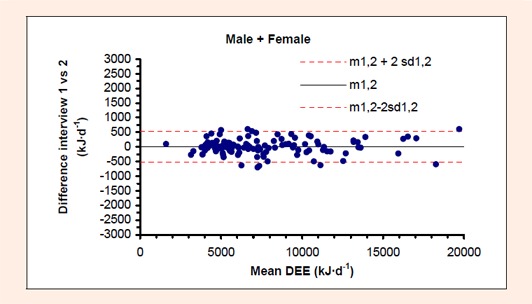
Test re-test study: Bland & Altman plot of the difference of the daily energy expenditure estimates between the test-retest periods versus their corresponding mean in the whole sample.
Figure 2.
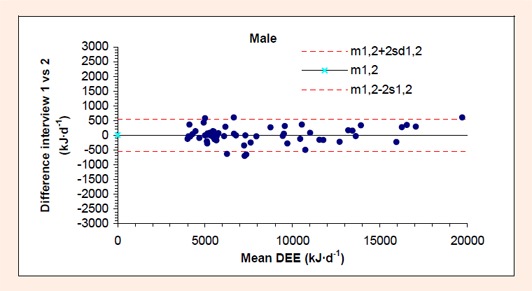
Test-retest study: Bland & Altman plot of the difference of the daily energy expenditure estimates versus their corresponding mean in the sample restricted to boys.
Figure 3.
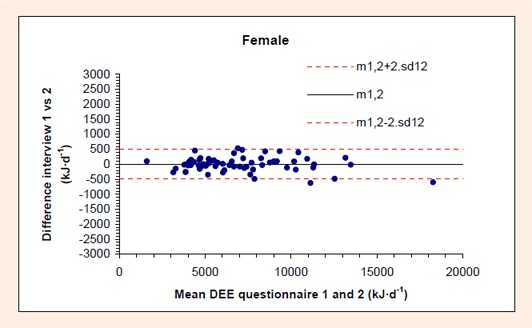
Test-retest study: Bland & Altman plot of the difference of the daily energy expenditure estimates versus their corresponding mean in the sample restricted to girls.
In order to estimate the variability capacity of the DEE according to the daily activities as recorded by the questionnaire, the mean durations for each of the thirteen categories of activities are shown (Table 4).
Table 4.
Mean (SD) durations of the different categories of PA during one representative week during school and the vacation periods as measured in a random sample of children and adolescents from 8 to16 years of age in Bogotá. NA: non applicable.
| Category | Questions | Description | School period (Hours/week) | Vacation period (Hours/week) |
|---|---|---|---|---|
| 1 | 1 | Sleeping: | 56.0 (7.0) | 56.0 (7.0) |
| 2 | 2, 3 | Toilet including bathing, dressing & undressing | 2.7 (1.75) | 2.7 (1.75) |
| 3 | 4, 5, 6 | Meals (eating): 3 meals | 7.8 (1.4) | 7.8 (1.4) |
| 4 | 7, 8 |
Transportation (to and from)
|
4.2 (.33) 1.5 (.25) 5.8 (.37) |
NA |
| 5 | 9, 10 | Classroom activities + homework | 42.5 (5.0) | NA |
| 6 | 11 | Mandatory physical education | 3.0 (1.0) | NA |
| 7 | 12 | Other activities in school: artistic (music, dancing, theater, arts, etc), craft activities and additional sports of leisure. | 2.5 (.75) | NA |
| 8 | 13 | Out school activities: miscellaneous activities (deskwork, TV watching, videogames, Music listening, reading and leisure sport activities, etc) | 17.5 (.5) | NA |
| 9 | 14 | Religious activities | .75 (.25) | .75 (.25) |
| 10 | 15 | Idem 8 but during vacation time | NA | 59.5 (7.0) |
| 11 | 16 | Personal artistic activities not associated with school | 2.0 (.5) | 2.0 (.5) |
| 12 | 17 | Sport competition and training (rare in our students) | 9.0 (6.0) | 9.0 (6.0) |
| 13 | 18 | Home activities sweeping, mopping, cleaning, washing laundry, ironing, cooking, child care, gardening, etc. | 7.5 (.75) | 7.5 (.75) |
In Table 4, the categories 1- 3, 9, 11-13 correspond to rather stable activities all year around, whereas the categories 4-7 and 8 correspond to stable activities during the school period. In the 7 x 24 hours = 168 hours of a school or vacation week, a mean of 157 (93.5 %) and 145.2 (86.4 %) hours/week, respectively, correspond to routinely fixed activities, leaving only 6.4% and 22.8 %, for variability in physical activities during the periods.
It can be noted that the highest correlation correspond to the rather fixed activities (Table 4: activities 1-3 and 5-12), whereas the lowest ones correspond to more variable activities (Distance and mode of Transportation and Home Activities).
Study 3: Validation study
The mean values of the observed CF, RQ and MRV suggest the rather good quality of the load reached by the students during the peak VO2 Test.
The overall mean DEE was 125.7 (SD 24.9) kJ·kg-1·min-1, whereas it was 135.5 (SD 28.8) (boys) and 115.9 (SD 15.6) (girls). The mean values of DEE were higher in boys than in girls, whether they were considered over one year or separately over the school or vacation periods (Table 5).
Table 5.
Descriptive statistic for the total sample and by gender. Data are means (±SD).
| Variable | All (N = 36) | Males (N = 18) | Females (N = 18) |
|---|---|---|---|
| Age (yr) | 12.0 (2.6) | 12.0 (2.7) | 12.0 (2.7) |
| Weight (kg) | 41.9 (12.4) | 42.7 (16.3) | 41.2 (6.9) |
| Height (m) | 1.42 (.14) | 1.42 (.16) | 1.42 (.12) |
| Indirect peak VO2 (mL·kg-1·min-1) | 42.7 (6.0) | 46.2 (5.9) | 39.1 (3.6) |
| Peak VO2 mL·kg-1·min-1) | 44.5 (8.7) | 49.9 (7.7) | 39.2 (5.8) |
| Max. Heart Rate (beats·min-1) | 186.7 (9.9) | 188.6 (8.3) | 184.8 (11.1) |
| Respiratory Quotient | 1.00 (.07) | 1.02 (.08) | 1.00 (.06) |
| Minute Respiratory Volume (L·min-1) | 66.7 (17.9) | 73.4 (20.3) | 60.0 (12.1) |
| DEE school period (kJ·kg-1·day-1) | 133.3 (26.1) | 143.7 (30.0) | 123.0 (16.4) |
| DEE vacation period (kJ·kg-1·day-1) | 100.4 (25.6) | 108.4 (28.7) | 92.5 (18.2) |
| DEE total year- period (kJ·kg-1·day-1) | 125.7 (24.9) | 135.5 (28.8) | 115.9 (15.6) |
The relationship between the direct and indirect measurements of peak VO2 is shown on Figure 4. The general ICC is 0.91 (p < 0.01), whereas it was 0.96 (boys) and 0.67 (girls).
Figure 4.
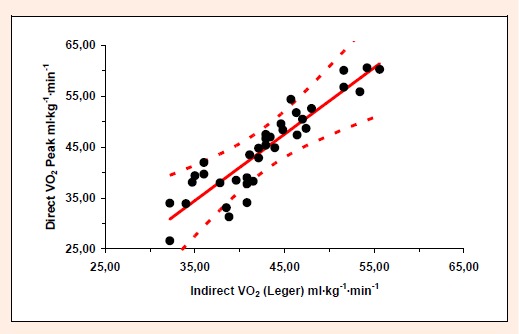
Correlation between Direct and Indirect VO2 (Lèger test).
The ICC between the indirect measurement of VO2 uptake and the overall mean DEE was 0.56 (p < 0.0001). The corresponding ICC between direct measurement of peak VO2 and the respective mean DEE was 0.69 (p < 0.00001). The ICC remained high for both school and vacation. They were lower in the female group as compared with the male group (Table 6), and increased with age category. The Bland-Altman plot between the DEE and the direct and indirect peak VO2 are shown in Figures 5 and 6.
Table 6.
Pearson interclass correlation coefficient (ICC) and the corresponding 95% confidence interval (95% CI) between energy expenditure either during school, vacation and whole year periods and both the indirect and direct peak VO2 measurements, by gender and group ages.
| Indirect VO2 | Direct VO2 | |||
|---|---|---|---|---|
| ICC | 95% CI | ICC | 95% CI | |
| All (N =36) | ||||
| School period (280 days) (kJ·kg-1·day-1) | .54 ** | .26-.74 | .67 ** | .43-.82 |
| Vacations period (85 days) (kJ·kg-1·day-1) | .52 ** | .23-.72 | .64 ** | .40-.80 |
| 12- month period (kJ·kg-1·day-1) | .56 ** | .28-.75 | .69 ** | .40-.80 |
| Males (N =18) | ||||
| School period (280 days) (kJ·kg-1·day-1) | .43 * | -.04 -.75 | .59 ** | .18-.83 |
| Vacations period (85 days) (kJ·kg-1·day-1) | .46 * | -.01-.76 | .63 ** | .23-.85 |
| 12- month period (kJ·kg-1·day-1) | .45 * | -.01-.76 | .63 ** | .22-.84 |
| Females (N =18) | ||||
| School period (280 days) (kJ·kg-1·day-1) | .34 | -.15-.69 | .57 ** | .14-.82 |
| Vacations period (85 days) (kJ·kg-1·day-1) | .37 | -.11-.71 | .55 ** | .11-.81 |
| 12- month period (kJ·kg-1·day-1) | .37 | -.12-.71 | .61 ** | .18-.83 |
| (8-10 years) (N =12) | ||||
| School period (280 days) (kJ·kg-1·day-1) | .44 * | -.18-.81 | .64 ** | .10-.89 |
| Vacations period (85 days) (kJ·kg-1·day-1) | .39 ** | -.23-.79 | .57 * | .00-.86 |
| 12- month period (kJ·kg-1·day-1) | .44* | -.18-.81 | .64 ** | .10-.89 |
| (11-13 years) (N =12) | ||||
| School period (280 days) (kJ·kg-1·day-1) | .71 ** | .23-.91 | .69 ** | .20-.91 |
| Vacations period (85 days) (kJ·kg-1·day-1) | .78 * | .36-.93 | .78 ** | .38-.94 |
| 12- month period (kJ·kg-1·day-1) | .78 ** | .36-.93 | .76 ** | .34-.93 |
| (14-16 years) (N =12) | ||||
| School period (280 days) (kJ·kg-1·day-1) | .82 ** | .46-.95 | .89 ** | .64-.97 |
| Vacations period (85 days) (kJ·kg-1·day-1) | .73 ** | .28-.95 | .78 ** | .38-.94 |
| 12- month period (kJ·kg-1·day-1) | .82 ** | .47-.95 | .89 ** | .64-.97 |
* p < 0.05
** p < 0.01
Figure 5.
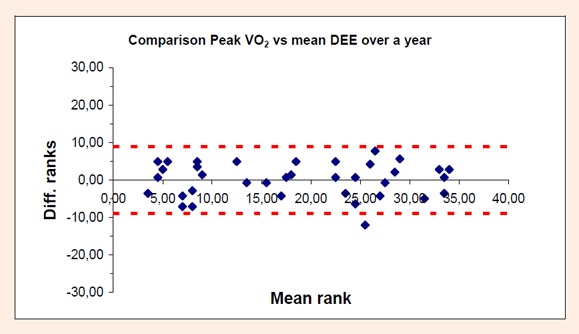
Bland-Altman plot showing the relationship of the mean daily energy expenditure and peak VO2 in all subjects based on the respective ranks of the corresponding values of the direct VO2 and the mean DEE.
Figure 6.
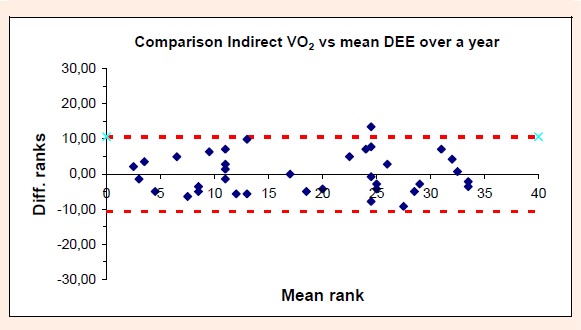
Bland-Altman plot showing the relationship of the mean daily energy expenditure and indirect VO2 in all subjects, based on the respective ranks of the corresponding values of the indirect VO2 and the mean DEE.
Discussion
The aim of the present study was to assess the reproducibility and validity of the QAPACE questionnaire in a random sample of children attending school in the city of Bogotá, as a preliminary step for a large-scale study aiming to evaluate PA in the corresponding population. The 30 min average time needed to fill the questionnaire doesn’t exceed the mental concentration capacity of youngsters and has showed a high reproducibility, although the youngest subjects used more time completing the questionnaire.
Generally, children are unable to estimate accurately the duration of an activity. For them, intensity and enjoyment are directly tied to the duration of any activity. To make things easier for the subjects, especially for the youngest ones, different specific periods of time (15 min, 30 min, 45 min, 60+ min) were offered, so as to improve the accuracy while completing the questionnaire [Montoye, 1996).
The questionnaire was designed to measure the mean DEE over the past year, during school and vacation, 24 hours a day. We believe that the repeated previous comprehension tests, the presence of a supervisor, the limited size of the group with the possibility of answering to their questions could explain the high reproducibility.
The delay of 6 weeks between the two test-retest sessions could have been too short to detect changes in activities. The six weeks detainment between the test-retest was reported to represent the minimal time for a subject to forget the previous responses (McDowell, 1987). The delays in the studies reported in the literature can be 10 days (Vuillemin et al., 2000), 15 days (Booth et al., 2001), one month (Aaron et al., 1993), 3 months (Aaron et al., 1995; Berthouze et al., 1993), 6 months (Pols et al., 1997) or one year (Aaron et al., 1995).
It has been reported that surveys focusing on a one year time frame are more likely to reflect usual activity patterns than those recording activities over a few days or over the past week (Kriska and Caspersen, 1997).
The ICC was lower, in the youngest and oldest groups, which could correspond to ages with less concentration or unstable behavior. The ICC were higher in children from higher socio-economic status and for the categories corresponding to a personal choice like artistic activities, sport competition and vacation whereas they were lower for home activities or transportation, corresponding to mandatory or uncomfortable activities.
Few studies have examined the reproducibility and validity of a questionnaire in children on the yearly PA using a self-administered but supervised modality. Thus, direct comparisons with other studies differing in test instrument, population and time frame should remain cautious. Nevertheless, the reproducibility coefficients were comparable to the ones reported with respect to the different test-retest time intervals. The studies in children show ICC between 0.66 and 0.98 with time intervals between 6 days and 1 year (Aaron et al., 1995; Baecke et al., 1982; Berthouze et al., 1993; Bouchard et al., 1983; Garcia et al., 1997; Kowalski et al., 1997; Pols et al., 1997; Sallis et al., 1993, Taylor et al., 1978; Weston et al., 1997).
In adults, the following ICCs were reported as: 0.91 (6-10 days) (Bouchard et al., 1983), 0.89 (1 month) and 0.69 (1 year) (Taylor et al., 1978), 0.89 (1 month) and 0.79 (11 months) (Baecke et al., 1982), 0.997 (7 days) (Berthouze et al., 1993), 0.83 (95% C.I. 0.66- 0.99) (10 days) (Vuillemin et al., 2000). In a self-administered survey using 1 day PA recall questionnaire concerning 90 American teenagers from 7th to 8th grades (mean age 14 years), the ICC was in the range 0.98 to 0.99 using the heart rate method, Caltrac and pedometer measurements of 0.43, 0.77 and 0.88 (Weston et al., 1997).
When the CAINM questionnaire was applied to a Spanish speaking population of school children from Mexico City (Hernandez et al., 2000), both the children and their mothers were tested six months apart on the children activities and the results were compared. The correlation coefficients, adjusted on age, gender and socio-economic level, ranged between 0.09 and 0.55. This study dealt mainly with low socio-economic population.
The capacity of extrapolating the results of the reproducibility study to a large survey relies on the modalities of selection of the sample of schoolchildren. In the Validity study a significant correlation between the estimated global DEE and both the indirect peak VO2 measurement (Leger test) and the direct peak VO2 measurement were found.
The lower ICC observed in girls could be explained either by a different body composition between girls and boys with a higher fat mass in the former and a higher lean mass in the latter. This difference in mass conveys that the subjects with higher lean mass present a greater capacity for effort expressed in peak VO2 and strength, and a lower motivation for physical activity in teenage girls (Aaron et al., 1993, Cooper, 1996). The measurements of peak VO2 were lower in girls, by 23% in direct measurements and 17% in indirect measurements, all differences previously reported in the literature (Flandrois et al., 1982; MacMurray et al., 1998; Turley et al., 1997).
The global intra-class correlation coefficients (ICC) for the global measurements of PA showed a high ICC r = 0.96 (95% CI 0.95-0.97). The few studies which have been published addressing, specifically the validity of a self-administered but supervised questionnaire, aimed to estimate a mean PA index in children over the past year; therefore, direct comparisons with other studies differing in test instruments, the population studied, the time frame and the geographical location should remain cautious.
However, the ICC reported here appears comparable to the ICC of the Bouchard three day- questionnaire with PWC 150 or PWC 50/kg of respectively 0.70 and 0.27 (Bouchard et al., 1983) for a recalled period covering the last six to ten days; They are also comparable to the values of the ICC reported in other studies: 0.47 - 0.82 in a seven day recall questionnaire with the heart rate as the biological measurement (Sallis et al., 1993); 0.40 in children 4- 8 years, with the Estonian Questionnaire of the parents and their children and the heart rate (Harro, 1997); 0.38 for 7-9 years gymnasts; 0.42 for recreational in prepubertal girls with a 7 day- delay questionnaire and the Caltrac accelerometer in Scerpella et al., 2002. Also for a seven day recall questionnaire adapted to children with max VO2 as the biological measurement in Schmucker (Schmucker et al., 1985) the ICC was 0.67; 0.40 for boys and 0.23 for girls using a seven day recall questionnaire adapted to children and submaximal VO2 in cycle ergometer as the biological measurement in Suter (1993).
The correlations between the direct and indirect measurements of peak VO2 were similar to the values reported by McNaughton. (r = 0.87) (McNaughton et al., 1996) or Van Mechelen (r = 0.76) (Van Mechelen et al., 1986).
Conclusion
To our knowledge, no study has directly addressed the issue of estimating a yearly average PA including school and vacation periods. The majority of available data on the validity of PA questionnaires in children concerned short-term (one, three, seven days) or mid-term (months) recall of physical activities. The QAPACE questionnaire is valid for assessing the routine PA patterns of children and adolescents in the tested sample. As it was randomly selected through a two step procedure in the population of schoolchildren of Bogotá, the QAPACE questionnaire proved its reliability and accuracy for epidemiological study and the possibility to be used in large population studies.
Acknowledgments
The authors thank all those who participated in the study, Oded Bar-Or; Laurence Joubin, Colette Moreel, Necker Hospital, Paris; Diana Gavassa, José Chaar, Germán Garcia; Efrain Patiño, Jesús Reyes and Edgar Rodriguez; Alirio Rodriguez, from El Bosque University; Secretaría de Educación de Bogotá and Aide au Développement de la Médecine du Sport, France.
Biographies

Nicolas BARBOSA
Employment
Sports Medicine Program, School of Medicine, El Bosque University, Bogotá, Colombia.
Degree
MD
Research interests
Physical activity, ergospirometry, and sports medicine.
E-mail: nibarbosa@hotmail.com

Carlos E. SANCHEZ
Employment
Sports Medicine Program, School of Medicine, El Bosque University, Bogotá, Colombia.
Degree
MD
Research interests
Sports medicine epidemiology and kinanthropometry.
E-mail: carlosefrain@cable.net.co

Jose A. VERA
Employment
Sports Medicine Program, School of Medicine, El Bosque University, Bogotá, Colombia.
Degree
MD
Research interests
Physical fitness tests.
E-mail: joanvefe29@hotmail.com

Wilson PEREZ
Employment
Sports Medicine Program, School of Medicine, El Bosque University, Bogotá, Colombia.
Degree
MD
Research interests
Ergospirometry.
E-mail: wilanpevi@latinmail.com

Jean-christophe THALABARD
Employment
APHP & UMR CNRS MAP5, University Paris Descartes, 45, rue des Saints Peres, 75006 Paris, France.
Degree
MD, PhD
Research interests
Endocrinology and metabolism, Epidemiology.
E-mail: jean-christophe.thalabard@htd.aphp.fr

Michel RIEU
Employment
Physiology Laboratory of Adaptations, Medicine Faculty, Cochin Port Royal, René Descartes University -V, 15, rue de l'Ecole de Médicine 75270 Paris, France.
Degree
MD, PhD
Research interests
Exercise physiology.
E-mail: rieu.michel@wanadoo.fr
APPENDIX: (QAPACE, Quantification de l'Activite Physique en Altitude Chez le Enfants)
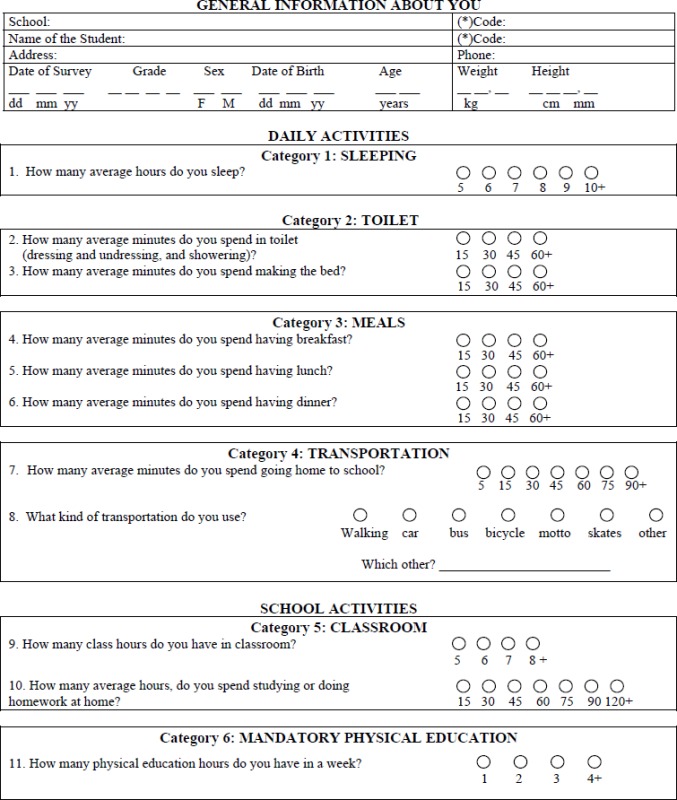
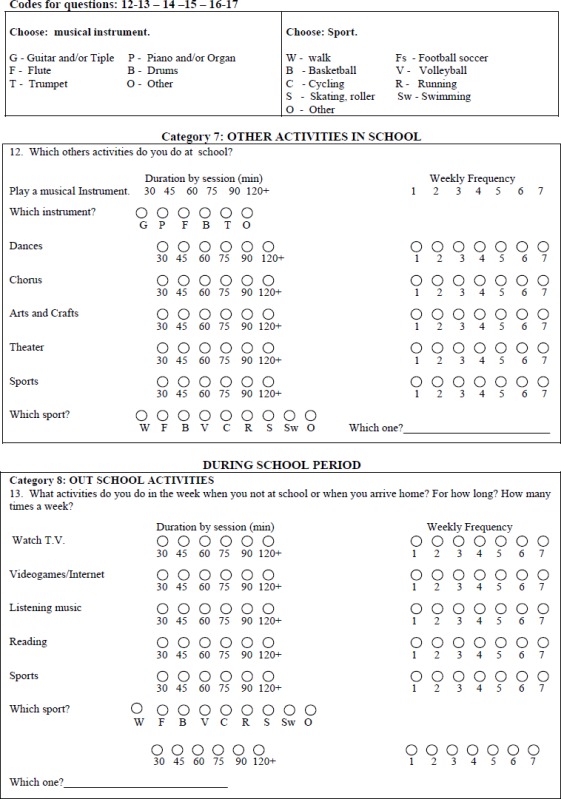
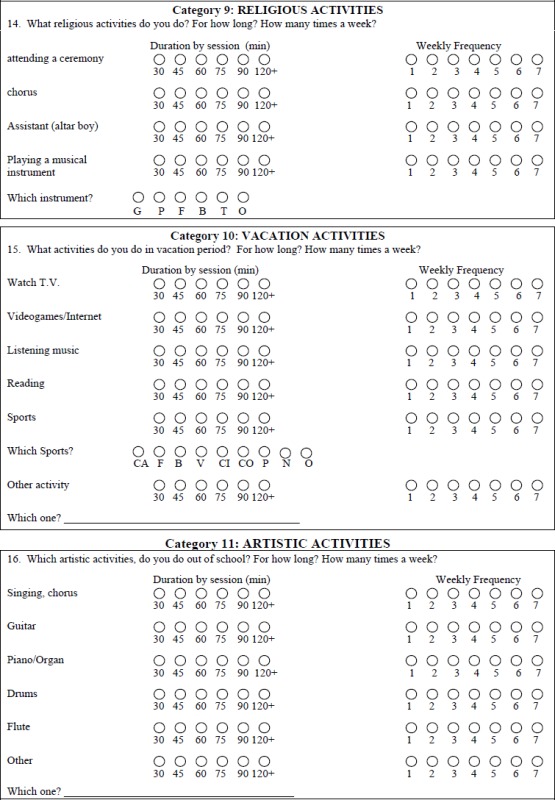
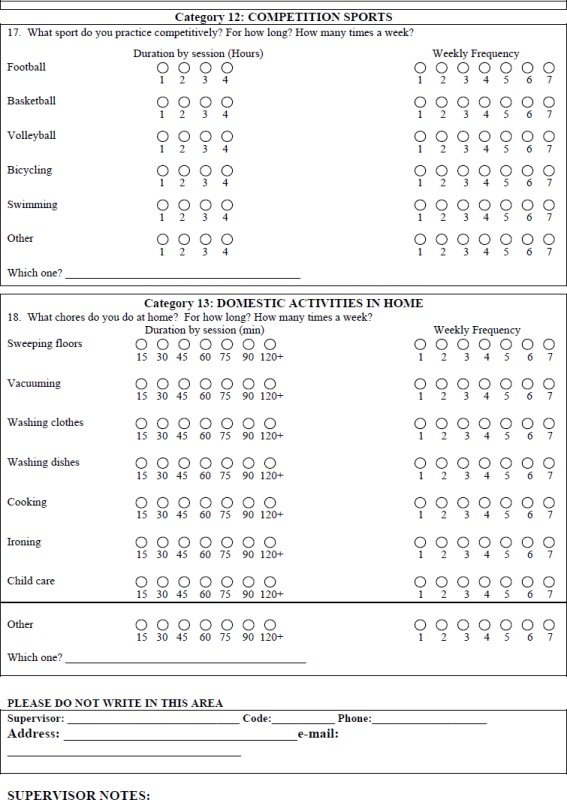
References
- Aaron D.J., Kriska A.M., Dearwater S.R., Anderson R.L., Olsen T.L., Cauley J.A., Laporte R.E. (1993) The epidemiology of leisure physical activity in an adolescent population. Medicine & Science in Sports & Exercise 25(7), 847-853 [DOI] [PubMed] [Google Scholar]
- Aaron D.J., Kriska A.M., Dearwater S.R., Cauley J.A., Metz K.F., LaPorte R.E. (1995) Reproducibility and validity of an epidemiologic questionnaire to assess past year physical activity in adolescents. American Journal of Epidemiology 142(2), 191-201 [DOI] [PubMed] [Google Scholar]
- Ainsworth B.E., Haskell W.L., Whitt M.C., Irwin M.L., Swartz A.M., Strath S.J., O'Brien W.L., Basset D.R., jr., Schmitz K.H., Emplaincourt P.O., Jacobs D.R., jr., Leon A.S. (2000) Compendium of physical activities: an update of activity codes and MET intensities. Medicine & Science in Sports & Exercise 32(Suppl. 9), S498-504 [DOI] [PubMed] [Google Scholar]
- Ainsworth B.E., Sternfeld B., Richardson M.T., Jackson K. (2000) Evaluation of the Kaiser Physical Activity Survey in women. Medicine & Science in Sports & Exercise 32(7), 1327-1338 [DOI] [PubMed] [Google Scholar]
- Baecke J.A., Burema J., Frijters J.E. (1982) A short questionnaire for the measurement of habitual physical activity in epidemiological studies. American Journal of Clinical Nutrition 36(5), 936-942 [DOI] [PubMed] [Google Scholar]
- Berthouze S.E., Minaire P.M., Chatard J.C., Boutet C., Castells J., Lacour J.R. (1993) A new tool for evaluating energy expenditure: the “QAPSE” development and validation. Medicine & Science in Sports & Exercise 25(12), 1405-1414 [PubMed] [Google Scholar]
- Bland J.M., Altman D.G. (1986) Statistical methods for assessing agreement between two methods of clinical measurement. Lancet 1(8476), 307-310 [PubMed] [Google Scholar]
- Booth M.L., Okely A.D., Chey T.N., Bauman A. (2002) The reliability and validity of the Adolescent Physical Activity Recall Questionnaire. Medicine & Science in Sports & Exercise 34(12), 1986-1995 [DOI] [PubMed] [Google Scholar]
- Booth M.L., Okely A.D., Chey T., Bauman A. (2001) The reliability and validity of the physical activity questions in the WHO health behaviour in schoolchildren (HBSC) survey: a population study. British Journal of Sports Medicine 35(4), 263-267 [DOI] [PMC free article] [PubMed] [Google Scholar]
- Bouchard C., Tremblay A., Leblanc C., Lortie G., Savard R., Theriault G. (1983) A method to assess energy expenditure in children and adults. American Journal of Clinical Nutrition 37(3), 461-467 [DOI] [PubMed] [Google Scholar]
- Caspersen C.J., Nixon P., Durant R. (1998) Physical activity epidemiology applied to children and adolescents. Exercise and Sport Sciences Reviews 23341-403 [PubMed] [Google Scholar]
- Cooper D.M. (1996) Cardiorespiratory and Metabolic Responses to Exercise In: Maturation and Growth. In: The Child and Adolescent Athlete. Bar-Or O.1st edition, Oxford: Blackwell Science Ltd.54-73 [Google Scholar]
- Flandrois R., Grandmontagne M., Maget M., Favier R., Frutoso J. (1982) La consommation maximale d’oxygène chez les jeunes français, sa variation avec l’âge, le sexe et l’entraînement. The Journal of Physiology 78, 186-194 (In French) [PubMed] [Google Scholar]
- Friedenreich M.C., Kerry S., Courney A., Bryant H.E. (1998) The Lifetime Total Physical Activity Questionnaire: development an reliability. Medicine & Science in Sports & Exercise 30(2), 266-274 [DOI] [PubMed] [Google Scholar]
- Garcia A.W., George T.R., Coviack C., Antonakos C., Pender NJ. (1997), Development of the child and adolescents activity log: A comprehensive and feasible measure of leisure-time physical activity. International Journal of a Behavioral Medicine 4, 323-338 [DOI] [PubMed] [Google Scholar]
- Harro M. (1997) Validation of a questionnaire to assess Physical Activity of children ages 4- 8 years. Research Quarterly For Exercise and Sport 68, 259-268 [DOI] [PubMed] [Google Scholar]
- Heberstreit H., Staschen B., Heberstreit A. (2000) Ventilatory threshold: a useful method to determine aerobic fitness in children?. Medicine & Science in Sports & Exercise 32(11), 1964-1969 [DOI] [PubMed] [Google Scholar]
- Hernandez B., Gortmaker S.L., Laird N.M., Colditz G.A., Parra-Cabrera S., Peterson K.E. (2000) Validity and reproducibility of a questionnaire on physical activity and non-activity for school children in Mexico City. Salud Publica de Mexico 42(4), 315-323 [PubMed] [Google Scholar]
- Kowalski K.C., Crocker P.R., Kowalski N.P. (1997) Convergent validity of the physical activity questionnaire for adolescents. Pediatric Exercise Science 9, 342-352 [Google Scholar]
- Kriska A., Caspersen C.J. (1997) Introduction to a collection of physical activity questionnaires. Medicine & Science in Sports & Exercise 29(6), S5-S9 [PubMed] [Google Scholar]
- Leger L., Lambert J. (1982) A maximal multistage 20-m shuttle run test to predict VO2 max. European Journal of Applied Physiology 49, 1-12 [DOI] [PubMed] [Google Scholar]
- MacMurray R., Guion W., Ainsworth B., Harrell J. (1998) Predicting aerobic power in children. Journal of Sports Medicine and Physical Fitness 38, 227-233 [PubMed] [Google Scholar]
- McDowell I., Newell C. (1987) Measuring health : a guide to rating scales and questionnaires. 1st edition. New York Oxford University Press, New York [Google Scholar]
- McNaughton D., Cooley D., Kearney V., Smith S. (1996) A comparison of two different shuttle run tests for the estimation of the VO2 max. Journal of Sports Medicine and Physical Fitness 36(2), 85-89 [PubMed] [Google Scholar]
- Montoye H.J., Kemper H.C.G., Saris W.H.M., Washburn R.A. (1996) Measuring physical activity and energy expenditure. 1st Edition. Human Kinetics, Champaign [Google Scholar]
- Philippaerts R.M., Lefevre J. (1998) Reliability and validity of three physical activity questionnaires in Flemish males. American Journal of Epidemiology 147(10), 982-990 [DOI] [PubMed] [Google Scholar]
- Pols M.A., Peeters P.H., Ocke M.C., Bueno-de-Mesquita H.B., Slimani N., Kemper H.C., Collette H.J. (1997) Relative validity and repeatability of a new questionnaire on physical activity.Preventive Medicine 26(1), 37-43 [DOI] [PubMed] [Google Scholar]
- Pols M.A., Peeters P.H., Ocke M.C., Slimani N., Bueno-de-Mesquita H.B., Collette H.J. (1997) Estimation of reproducibility and relative validity of the questions included in the EPIC Physical Activity Questionnaire. International Journal of Epidemiology 26(1), S181-189 [DOI] [PubMed] [Google Scholar]
- Rauh M., Hovell M., Hofstetter C., Sallis J., Gleghorn A. (1992) The reliability and validity of self- reported physical activity in an adult Latino sample. International Journal of Epidemiology 21, 966-971 [DOI] [PubMed] [Google Scholar]
- Sallis J.F., Buono M.J., Roby J.J., Micale F.G., Nelson J.A. (1993) Seven-day recall and other physical activity self-reports in children and adolescents. Medicine & Science in Sports & Exercise 25(1), 99-108 [DOI] [PubMed] [Google Scholar]
- Sallis J.F., Saellens B.E. (2000) Assessment of physical activity by self-report: Status, limitations, and future direction. Research Quarterly for Exercise and Sport 71(2), 1. [DOI] [PubMed] [Google Scholar]
- Saris W.H.M. (1996) Assessment of Energy Expenditure and Daily Physical Activity. The child and adolescent athlete. Bar-Or O.1st edition. Oxford: Blackwell Science Ltd.634-646 [Google Scholar]
- Scerpella T., Tuladhar P., Kanaley J. (2002) Validation of the Godin- Shephard questionnaire in prepubertal girls. Medicine & Science in Sports & Exercise 34(5), 845-850 [DOI] [PubMed] [Google Scholar]
- Schmucker B., Rigauer B., Hinrichs W., Trawinski J. (1985) Motor abilities and habitual physical activity in children. 1st edition. Springer- Verlag, Berlin [Google Scholar]
- Suter E., Hawes M. (1993) Relationship of physical activity, body fat diet, and blood lipid profile in youths 10- 15 years. Medicine & Science in Sports & Exercise 25, 748-754 [PubMed] [Google Scholar]
- Taylor H.L., Jacobs D.R. Jr., Schucker B., Knudsen J., Leon A.S., Debacker G. (1978) A questionnaire for the assessment of leisure time physical activities. Journal of Chronical Diseases 31(12), 741-755 [DOI] [PubMed] [Google Scholar]
- Turley K., Wilmore J. (1997) Cardiovascular responses to submaximal exercise in 7- to 9-yr-old boys and girls. Medicine & Science in Sports & Exercise 29, 824-832 [DOI] [PubMed] [Google Scholar]
- Van Mechelen W., Hlobil H., Kempert H. (1986) Validation of two running tests as estimate of maximal aerobic power in children. European Journal of Applied Physiology 55, 503-506 [DOI] [PubMed] [Google Scholar]
- Vuillemin A., Oppert J.M., Guillemin F., Essermeant L., Fontvieille A.M., Galan P., Kirska A.M., Hercberg S. (2000) Self-administered questionnaire compared with interview to assess past-year physical activity. Medicine & Science in Sports & Exercise 32(6), 1119-1124 [DOI] [PubMed] [Google Scholar]
- Washburn R., Jacobsen D., Sonko B., Donnelly J. (2003) The validity of the Stanford Seven- Day Physical Activity Recall in young adults. Medicine & Science in Sports & Exercise 35(8), 1374-1380 [DOI] [PubMed] [Google Scholar]
- Weston A.T., Petosa R., Pate R.R. (1997) Validation of an instrument for measurement of physical activity in youth. Medicine & Science in Sports & Exercise 29(1), 138-143 [DOI] [PubMed] [Google Scholar]


